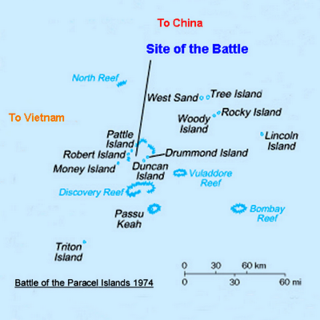Battle of the Paracel Islands
| Battle of the Paracel Islands | |||||||||
|---|---|---|---|---|---|---|---|---|---|
 |
|||||||||
|
|||||||||
| Belligerents | |||||||||
|
|
|
||||||||
| Commanders and leaders | |||||||||
|
|
|
||||||||
| Strength | |||||||||
| 4 minesweepers 2 submarine chasers Marine battalions Unknown number of militia |
3 frigates 1 corvette 1 commando platoon 1 demolition team 1 militia platoon |
||||||||
| Casualties and losses | |||||||||
| 18 killed Unknown number injured 4 minesweepers damaged |
53 killed 16 injured 48 captured 1 corvette sunk 3 frigates damaged |
||||||||
The Battle of the Paracel Islands was a military engagement between the naval forces of the People's Republic of China (PRC) and the Republic of Vietnam (South Vietnam) in the Paracel Islands on January 19, 1974. The battle was an attempt by the Republic of Vietnam Navy to expel the Chinese Navy from the vicinity.
As a result of the battle, the PRC established de facto control over the Paracels. As part of its "nine-dash line" boundary policy in the South China Sea, the PRC continues to claim authority over the surrounding waters. This claim has been persistently contested by Vietnam, the Philippines, and many international observers.
The Paracel Islands, called Xisha Islands (西沙群島; Xīshā Qúndǎo) in Chinese and Hoang Sa Islands (Quần Đảo Hoàng Sa) in Vietnamese, lie in the South China Sea lie approximately equidistant from the coastlines of the PRC and Vietnam (200 nautical miles). With no native population, the archipelago’s ownership has been in dispute since the early 20th century.
China first asserted sovereignty in the modern sense to the South China Sea’s islands when it formally objected to France’s efforts to incorporate them into French Indochina during the Sino-French War (1884–1885). Initially, France recognized Qing China's sovereignty over the Paracel and Spratly archipelagos, in exchange for Chinese recognition of Vietnam as a French territory. Chinese maps since then have consistently shown China’s claims, first as a solid and then as a dashed line. In 1932, one year after the Japanese Empire invaded northeast China, France formally claimed both the Paracel and Spratly Islands. China and Japan both protested. In 1933, France seized the Paracels and Spratlys, announced their annexation, formally included them in French Indochina. They built several weather stations on them, but they did not disturb the numerous Chinese fishermen found there. In 1938 Japan took the islands from France, garrisoned them, and built a submarine base at Itu Aba (now Taiping / 太平) Island. In 1941, the Japanese Empire made the Paracel and Spratly islands part of Taiwan, then under its rule.
...
Wikipedia
